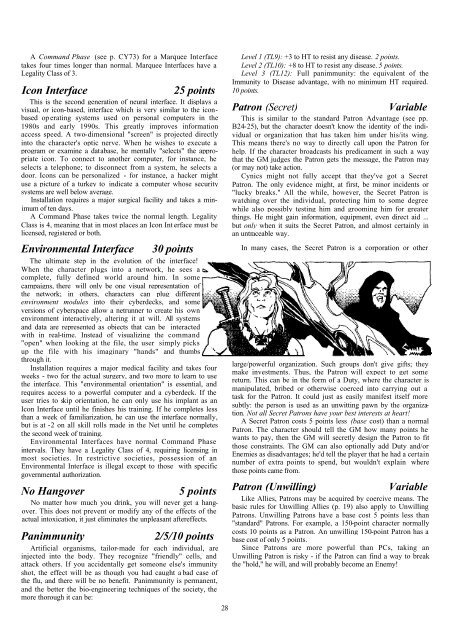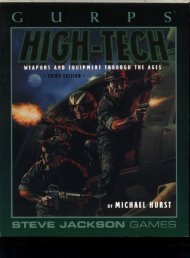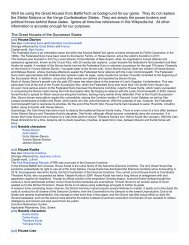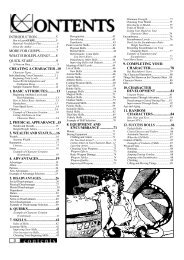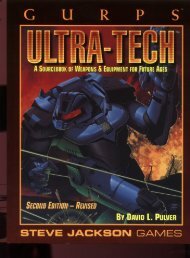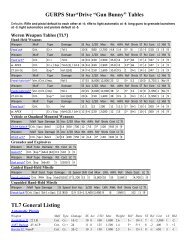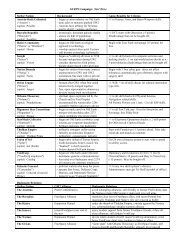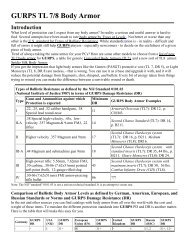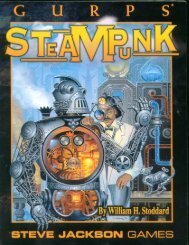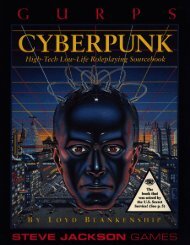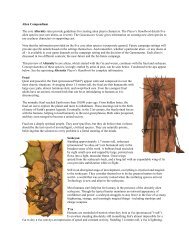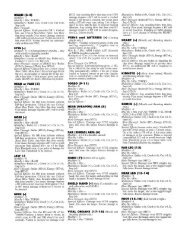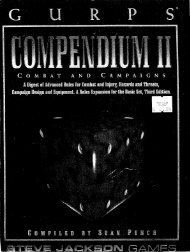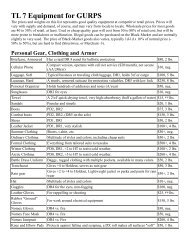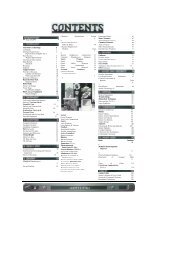GURPS - Compendium 1..
GURPS - Compendium 1..
GURPS - Compendium 1..
Create successful ePaper yourself
Turn your PDF publications into a flip-book with our unique Google optimized e-Paper software.
A Command Phase (see p. CY73) for a Marquee Interface<br />
takes four times longer than normal. Marquee Interfaces have a<br />
Legality Class of 3.<br />
Icon Interface<br />
25 points<br />
This is the second generation of neural interface. It displays a<br />
visual, or icon-based, interface which is very similar to the iconbased<br />
op erating systems used on personal computers in the<br />
1980s and early 1990s. This greatly improves information<br />
access speed. A two-dimensional "screen" is projected directly<br />
into the character's optic nerve. When he wishes to execute a<br />
program or examine a database, he mentally "selects" the appropriate<br />
icon. To connect to another computer, for instance, he<br />
selects a telephone; to disconnect from a system, he selects a<br />
door. Icons can be personalized - for instance, a hacker might<br />
use a picture of a turkey to indicate a computer whose security<br />
systems are well below average.<br />
Installation requires a major surgical facility and takes a minimum<br />
of ten days.<br />
A Command Phase takes twice the normal length. Legality<br />
Class is 4, meaning that in most places an Icon Int erface must be<br />
licensed, registered or both.<br />
Environmental Interface<br />
30 points<br />
The ultimate step in the evolution of the interface!<br />
When the character plugs into a network, he sees a<br />
complete, fully defined world around him. In some<br />
campaigns, there will only be one visual representation of<br />
the network; in others, characters can plug different<br />
environment modules into their cyberdecks, and some<br />
versions of cyberspace allow a netrunner to create his own<br />
environment interactively, altering it at will. All systems<br />
and data are represented as objects that can be interacted<br />
with in real-time. Instead of visualizing the command<br />
"open" when looking at the file, the user simply picks<br />
up the file with his imaginary "hands" and thumbs<br />
through it.<br />
Installation requires a major medical facility and takes four<br />
weeks - two for the actual surgery, and two more to learn to use<br />
the interface. This "environmental orientation" is essential, and<br />
requires access to a powerful computer and a cyberdeck. If the<br />
user tries to skip orientation, he can only use his implant as an<br />
Icon Interface until he finishes his training. If he completes less<br />
than a week of familiarization, he can use the interface normally,<br />
but is at -2 on all skill rolls made in the Net until he completes<br />
the second week of training.<br />
Environmental Interfaces have normal Command Phase<br />
intervals. They have a Legality Class of 4, requiring licensing in<br />
most societies. In restrictive societies, possession of an<br />
Environmental Interface is illegal except to those with specific<br />
governmental authorization.<br />
No Hangover<br />
5 points<br />
No matter how much you drink, you will never get a hangover.<br />
This does not prevent or modify any of the effects of the<br />
actual intoxication, it just eliminates the unpleasant aftereffects.<br />
Panimmunity<br />
2/5/10 points<br />
Artificial organisms, tailor-made for each individual, are<br />
injected into the body. They recognize "friendly" cells, and<br />
attack others. If you accidentally get someone else's immunity<br />
shot, the effect will be as though you had caught a bad case of<br />
the flu, and there will be no benefit. Panimmunity is permanent,<br />
and the better the bio-engineering techniques of the society, the<br />
more thorough it can be:<br />
28<br />
Level 1 (TL9): +3 to HT to resist any disease. 2 points.<br />
Level 2 (TL10): +8 to HT to resist any disease. 5 points.<br />
Level 3 (TL12): Full panimmunity: the equivalent of the<br />
Immunity to Disease advantage, with no minimum HT required.<br />
10 points.<br />
Patron (Secret)<br />
Variable<br />
This is similar to the standard Patron Advantage (see pp.<br />
B24-25), but the character doesn't know the identity of the individual<br />
or organization that has taken him under his/its wing.<br />
This means there's no way to directly call upon the Patron for<br />
help. If the character broadcasts his predicament in such a way<br />
that the GM judges the Patron gets the message, the Patron may<br />
(or may not) take action.<br />
Cynics might not fully accept that they've got a Secret<br />
Patron. The only evidence might, at first, be minor incidents or<br />
"lucky breaks." All the while, however, the Secret Patron is<br />
watching over the individual, protecting him to some degree<br />
while also possibly testing him and grooming him for greater<br />
things. He might gain information, equipment, even direct aid ...<br />
but only when it suits the Secret Patron, and almost certainly in<br />
an untraceable way.<br />
In many cases, the Secret Patron is a corporation or other<br />
large/powerful organization. Such groups don't give gifts; they<br />
make investments. Thus, the Patron will expect to get some<br />
return. This can be in the form of a Duty, where the character is<br />
manipulated, bribed or otherwise coerced into carrying out a<br />
task for the Patron. It could just as easily manifest itself more<br />
subtly: the person is used as an unwitting pawn by the organization.<br />
Not all Secret Patrons have your best interests at heart!<br />
A Secret Patron costs 5 points less (base cost) than a normal<br />
Patron. The character should tell the GM how many points he<br />
wants to pay, then the GM will secretly design the Patron to fit<br />
those constraints. The GM can also optionally add Duty and/or<br />
Enemies as disadvantages; he'd tell the player that he had a certain<br />
number of extra points to spend, but wouldn't explain where<br />
those points came from.<br />
Patron (Unwilling)<br />
Variable<br />
Like Allies, Patrons may be acquired by coercive means. The<br />
basic rules for Unwilling Allies (p. 19) also apply to Unwilling<br />
Patrons. Unwilling Patrons have a base cost 5 points less than<br />
"standard" Patrons. For example, a 150-point character normally<br />
costs 10 points as a Patron. An unwilling 150-point Patron has a<br />
base cost of only 5 points.<br />
Since Patrons are more powerful than PCs, taking an<br />
Unwilling Patron is risky - if the Patron can find a way to break<br />
the "hold," he will, and will probably become an Enemy!


